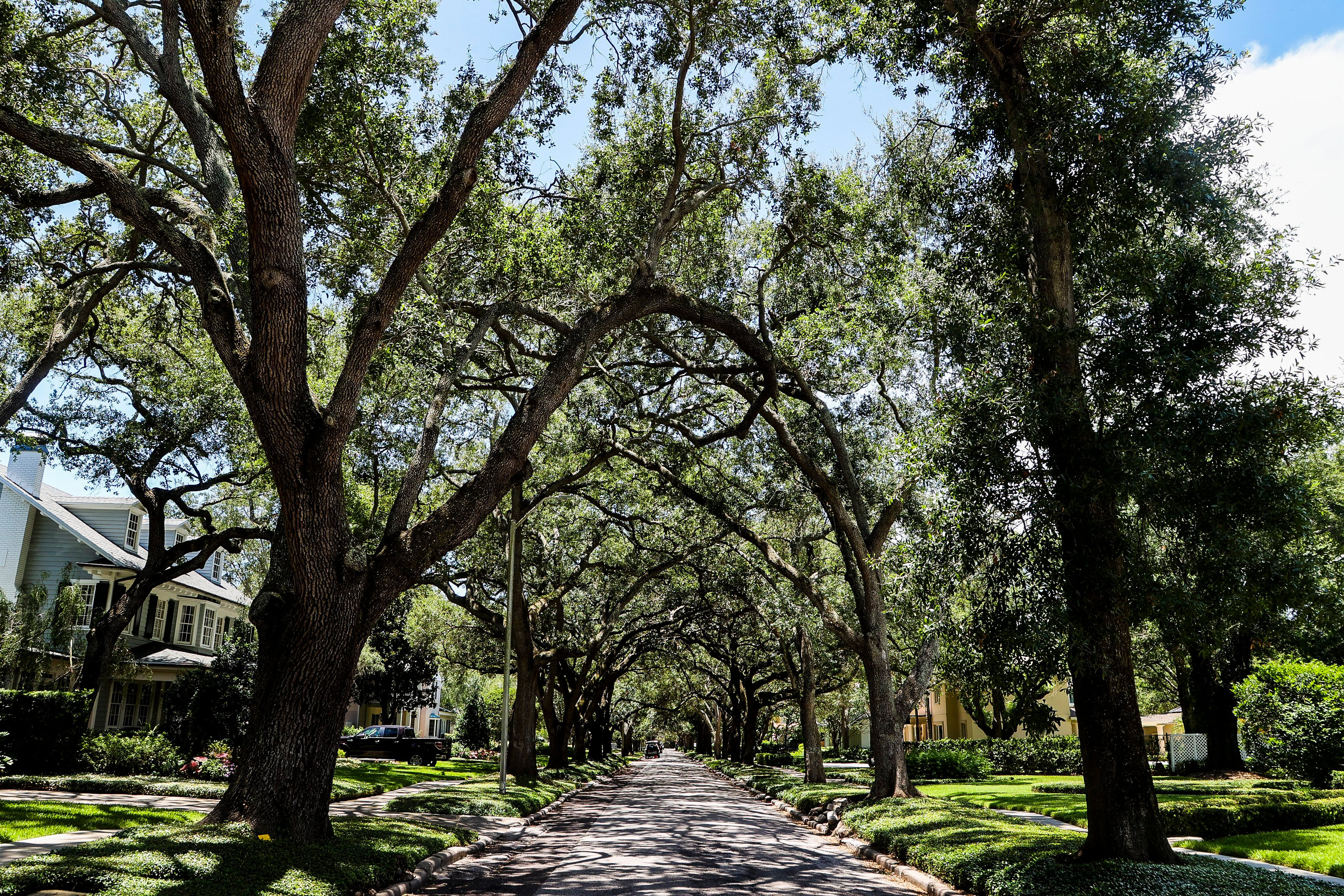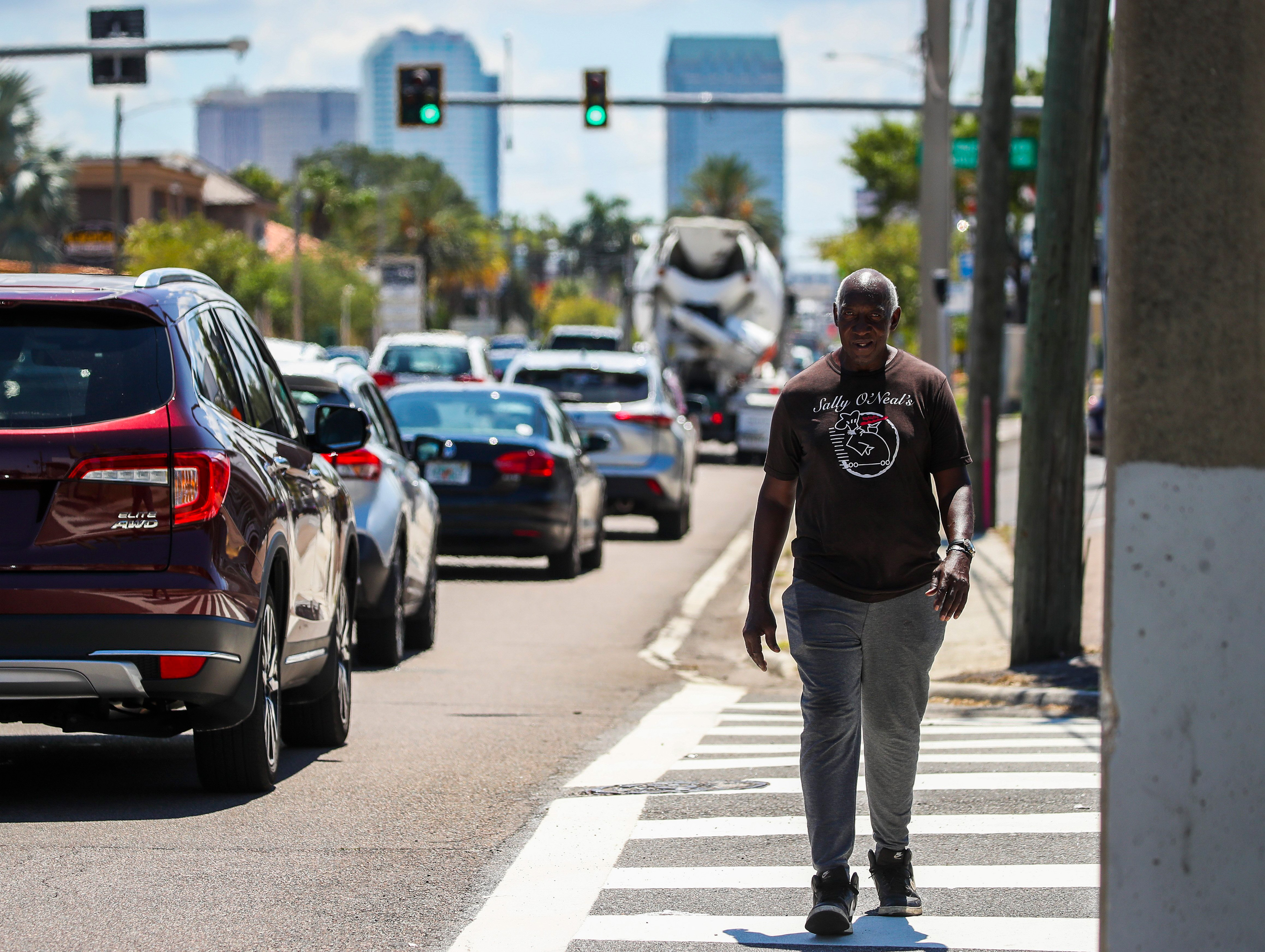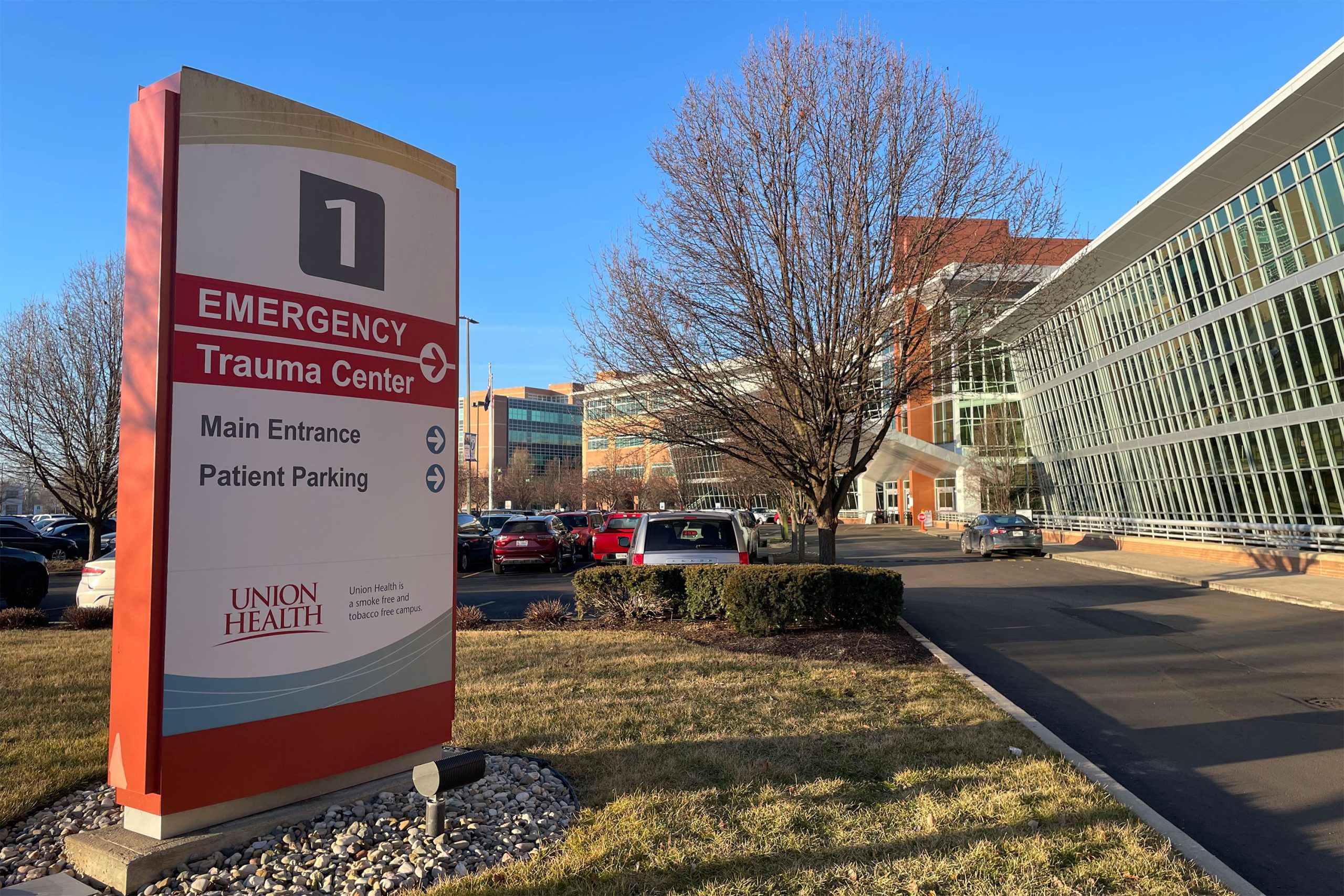TAMPA, Fla. — If it weren’t for the traffic along South MacDill Avenue, Javonne Mansfield swears you could hear the sizzle of a frying pan.
The sun is scorching with such violent intensity that even weathered Floridians can’t help but take note.
In a hard hat, Mansfield pushes a shovel into the earth. Heat radiates from the road, the concrete parking lots. It’s around 10:30 a.m., and his crew is starting a 10-hour shift fixing traffic lights in West Tampa. Cloud coverage is minimal — thin and wispy. There’s no greenery or trees to shield them, no refuge from the blistering sun.
“I can feel it,” Mansfield says, “like I’m cooking.”
A mile south, near Palma Ceia Golf and Country Club in South Tampa, Kiki Mercier walks a poodle mix along a row of stately homes. It’s the same city on the same July day, but here, the heat feels different.
Plush lawns spotted with children’s toys help absorb the sun’s rays. But it’s the dozens of live oak trees with sprawling branches that make the biggest difference to Mercier, who walks dogs for a living.
Here, it feels possible to be outside, protected by natural tunnels of shade.
As the climate warms, a person’s health and quality of life hinge, in part, on the block where they live or work. Green space and shade can be the difference between a child playing outside and being stuck inside on hot summer days, the difference between an elderly person fainting while waiting for a bus and boarding safely, the difference between a construction worker suffering heatstroke on the job and going home to their family.
Neighborhoods with more trees and green space stay cooler, while those coated with layers of asphalt swelter. Lower-income neighborhoods tend to be hottest, a city report found, and they have the least tree canopy.
The same is true in cities across the country, where poor and minority neighborhoods disproportionately suffer the consequences of rising temperatures. Research shows the temperatures in a single city, from Portland, Oregon, to Baltimore, can vary by up to 20 degrees. For a resident in a leafy suburb, a steamy summer day may feel uncomfortable. But for their friend a few neighborhoods over, it’s more than uncomfortable — it’s dangerous.
Last month was Tampa Bay’s hottest ever. As Americans brace for an increasing number of hot days and extreme weather events linked to climate change, medical professionals stress that rising heat will make health inequities worse.
“Heat affects quality of life,” said Cheryl Holder, co-founder and interim director of Florida Clinicians for Climate Action, a coalition of medical professionals that advocates for solutions to climate change. “It’s poor and vulnerable patients who are suffering.”
Now, cities like Tampa are trying to build heat resiliency into their infrastructure — including by boosting their tree canopy — all while experts warn of a public health threat growing more severe each year.

Unrelenting Heat
As a human body warms, sweat gathers and evaporates from the skin, transferring heat away and into the air.
But in Florida, humidity hangs like a blanket, making it harder for the body’s cooling system to work.
“The sweat just doesn’t evaporate, so you don’t lose heat as effectively,” said Patrick Mularoni, a sports medicine physician at Johns Hopkins All Children’s Hospital in St. Petersburg.
In these unrelenting summer months, doctors like Mularoni have seen up close the toll heat can take.
Muscle cramps and headaches. Fatigue. Heatstroke — which can be fatal.
Daily temperatures are one benchmark of heat’s impact, but factors like humidity, wind speed, and sun angle also affect the toll on the body.
The heat index, often called the “feels like” temperature, accounts for temperature plus the added burden of humidity. For instance, while the thermometer may read 91 degrees, the heat index means it can feel like 110 degrees. The National Weather Service defines any heat index of 105 degrees or higher as dangerous.
Between 1971 and 2000, Tampa saw about four days a year with a heat index greater than 105 degrees.
By 2036, that number is projected to jump to as many as 80 days a year.
Without extreme steps to reduce global temperatures, scientists predict, Tampa residents will experience 127 “dangerous” days annually by 2099 — more than a third of the calendar year.
When the body temperature goes up to 104 as a result of overheating, the body begins dysregulating and shutting down. Decreased blood flow to the organs can cause multisystem organ failure.
Without prompt intervention to lower the body temperature, according to the Centers for Disease Control and Prevention, heatstroke can be fatal.
This summer, heat waves have killed at least 13 people in Texas and one in Louisiana, where the heat index reached 115 degrees. In Arizona, at least 18 people have died, and 69 other deaths were being investigated for potential links to heat illness. Other Arizonans have been hospitalized for serious burn injuries after touching scalding concrete.
As far north as Maryland, a 52-year-old man died in July — the state’s first recorded heat-related death of the year.
And in Parkland, Florida, a 28-year-old farm worker died of heat exposure in January after he’d spent hours pulling weeds and propping up bell pepper plants. Investigators said his death was preventable. He’d recently moved from Mexico; it was his first day on the job.
In Tampa, a Shrinking Canopy
Last year was Tampa’s hottest to date.
The city’s average annual temperature has risen by 2.5 degrees since record-keeping began in 1891, according to the city’s Climate Action and Equity Plan.
All the while, a natural tool for reducing heat has been slowly disappearing. According to a 2021 study, tree canopy coverage in Tampa is at its lowest in 26 years.
Experts say vanishing tree cover coupled with hotter summers is a lethal combination.
The uneven distribution of trees — and therefore shade — means lower-income and Hispanic neighborhoods are more affected by heat, Tampa’s city report found.
MacFarlane Park, east of Tampa International Airport, ranks among the least shady areas of the city, according to the report. It has 21{dec8eed80f8408bfe0c8cb968907362b371b4140b1eb4f4e531a2b1c1a9556e5} canopy coverage, or nearly a third less than the city average.
Only 15{dec8eed80f8408bfe0c8cb968907362b371b4140b1eb4f4e531a2b1c1a9556e5} of East Ybor City and 18{dec8eed80f8408bfe0c8cb968907362b371b4140b1eb4f4e531a2b1c1a9556e5} of North Hyde Park benefit from tree cover. All these neighborhoods have gradually lost trees over the past few decades.
Many factors influence the shrinking canopy, the city’s analysis found, including the loss of old and dying trees and the removal of trees for construction. In some lower-income neighborhoods, residents have chosen to cut trees down because they can’t afford the upkeep, or because dangling branches pose a threat.
Some wealthier areas are seeing faster and more recent canopy loss as old trees die or are cut down, but their total tree cover is still double that of poorer neighborhoods.
On the upper end, the canopy of mansion-lined Bayshore Boulevard is not far behind those of a series of housing developments along Flatwoods Park in New Tampa, one of which hovers around 73{dec8eed80f8408bfe0c8cb968907362b371b4140b1eb4f4e531a2b1c1a9556e5} coverage.
Gray Gables, a neighborhood bordering West Kennedy Boulevard, lost the highest proportion of trees from 2016 to 2021, but canopy still covers 38{dec8eed80f8408bfe0c8cb968907362b371b4140b1eb4f4e531a2b1c1a9556e5} of its total area.
It’s not just shade the city is losing. Trees release water vapor, which helps cool people off. Each year, according to the city’s 2021 canopy study, Tampa’s trees remove 1,000 tons of air pollutants, capture the potential carbon dioxide emissions of 847 tanker trucks’ worth of gasoline, and reduce stormwater runoff equal to 850 Olympic swimming pools.
Natural shade also determines the paths people walk — or whether they walk at all — and how often their kids can play in the yard.
On a July day in West Tampa, a girl on a bike squints as she pedals, beads of sweat dripping from her brow. A woman pushing a stroller contorts her body while waiting for the bus, trying to make use of a strip of shade no wider than 6 inches, cast from a traffic pole.
Angela Morris stands in her sun-drenched driveway and rinses sandy beach toys with a hose. She’s layered in sunscreen, but in the blazing heat, her skin is already burning.
“It’s almost unbearable,” Morris says. Her kids — ages 2 and 5 — are inside.
Do they ever play outside in the summer?
“Never,” Morris says. “It’s a lot of younger families with kids who would benefit from some shade and a sidewalk.”

Data Deficiency Poses Problems
Heat-related deaths also prove difficult to track.
A doctor might code a fatal heart attack on an extremely hot day as a cardiovascular event without noting, for example, that heat likely exacerbated the condition.
“What often gets lost are the circumstances surrounding deaths and illness,” said Christopher Uejio, a Florida State University researcher who studies the effects of climate on health and has led data projects for cities around the country.
Extreme heat in the U.S. kills more people than hurricanes, floods, and tornadoes put together, according to the National Weather Service. It’s the country’s No. 1 weather-related cause of death.
About 67,500 emergency room visits and just over 9,000 hospitalizations across the U.S. each year are tied to heat, according to the CDC.
But those numbers account only for instances in which doctors specifically code the visit as a heat-related event.
Similarly, between 2004 and 2018, an average of only 702 heat-related deaths across the country were reported to the CDC.
“We know that’s a pretty gross underestimate,” said Uejio. “Our best scientific estimates are anywhere between 5,000 to 12,000 deaths in the United States due to conditions exacerbated by heat each year.”
Low reporting continues today, experts say.
Despite patchy reporting, it appears heat-related deaths are on the rise. Last year’s number of estimated deaths was more than double the number from a decade ago.
Medical schools must teach doctors to look for and document heat-related illness, said Holder, of Florida Clinicians for Climate Action. Her group has held lectures for students and doctors on topics like the effects of climate change on patients.
Holder said she has seen how heat exposure over time harms the predominantly low-income and minority patients she served in her community clinic in South Florida.
There was the elderly man who had signs of worsening kidney function on days when he worked long shifts selling fruit on hot Miami streets.
The mother whose asthma worsened as temperatures rose.
The Fort Lauderdale woman with chronic lung disease who was arrested for fighting with her daughter over a fan. She died three days after returning to her broiling apartment.
A More Resilient City
That the tree canopy is shrinking is no surprise to city officials. In April, Tampa Mayor Jane Castor set a goal of planting 30,000 trees by 2030.
Whit Remer, Tampa’s sustainability and resilience officer, said the target might be difficult to nail.
Remer said trees are competing for space in the right of way with sidewalks and utilities. Limited open land also poses a challenge. Tampa has no room for new parks, he said. Now, it’s about maximizing that finite green space.
“Planting trees has been the hardest thing that I have done as the city’s resilience officer,” Remer said.
Remer said he’s looking to other cities for solutions. In Phoenix, a “cool pavement” pilot program uses a water-based asphalt layer to reflect heat off roads. Last year, Miami-Dade County appointed the world’s first chief heat officer. Washington and Oregon have begun distributing thousands of air conditioning units to vulnerable residents and barred utility companies from cutting power to homes during heat waves.
Remer said Tampa is still in its “learning and listening” phase. Last year, the city was awarded $300,000 by the National Academies of Sciences, Engineering, and Medicine to develop a guide for understanding and fighting the effects of heat in East Tampa, a predominantly Black neighborhood, where at least a third of children live below the poverty line.
The project director is Taryn Sabia, an urban designer and associate dean at the University of South Florida who focuses on climate resiliency work, which spans hurricane preparedness, flooding, and, increasingly, extreme heat.
Planting trees is helpful, Sabia said, but they take time to grow and effort to maintain. Quicker actions could include erecting better shade structures at bus stops or implementing rules for construction to encourage the use of materials that generate less heat in the sun. For example, some cities in the Northeast — including Philadelphia and New York — provide financial incentives for “green roofs,” in which the top of a building is covered with plants.
Another easy step: painting everything white. Light colors reflect sunlight, while dark colors absorb heat.
And while Florida codes require homes to have a mechanism to provide heat in the winter, there are no codes requiring landlords to provide air conditioning.
“You can no longer be here and not have it,” Sabia said.
Tampa could better tailor weather advisories for specific needs and neighborhoods, she said. Heat becomes more dangerous more quickly on upper floors of older apartments, for example, because heat rises. Expanding access to cooling shelters is also key.
It’s the hottest week of the year so far in Tampa, and 75-year-old Benjamin Brown is walking home from the eye doctor, about a 30-minute walk.
There are few trees in sight, but Brown, who is without a car, makes a similar trek every day, running errands, visiting friends.
“It’s very oppressive. It does get to me,” Brown says as he nods, wipes his forehead, and continues down the street in the blistering Tampa sun.
Shade — any shade — would be a lifesaver, he said.

This article was produced in partnership with the Tampa Bay Times.









